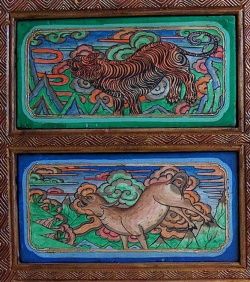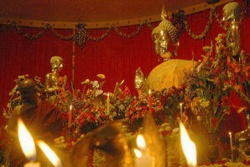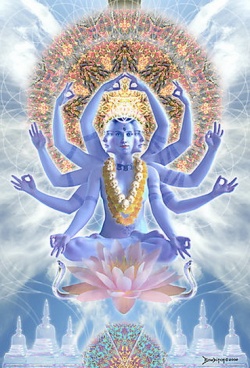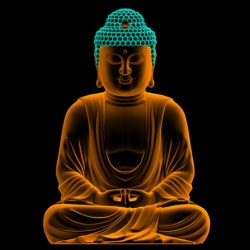Motion and Rest from a Chinese Buddhist Perspective
Seng-Chao’s writing as a Chinese Buddhist signified the start to a new development in Buddhist philosophy in China.
1 He was one of the first writers to draw on a tradition called the Three-Treatise (or Middle Doctrine) School, which had come over from India in the form of three significant texts, namely Nāgārjuna’s Treatise on the Middle way, and Treatise on the Twelve Gates and Āryadeva’s3 One-Hundred-Verse Treatise, which were translated into Chinese.
4 Seng-Chao was one of the earliest Chinese philosophers interested in making a place for Buddhism within a traditionally Taoist and Confucian society.
While his work is grounded in distinctly Buddhist ideas, there are definite Taoist influences to his perspective. In this paper I will outline Seng-Chao’s discussion of motion and rest, drawing on connections this argument has with Nāgārjuna’s account of motion and Śāntaraksita’s5 account of consciousness and memory in relation to the perception of images. Next I will examine Seng-Chao’s discussion of time and the relationship between past, present and future. I will make connections to Candrakīrti’s6 account of memory and its implications on Stance Volume 1
Caroline Sluyter
Smith College
ABSTRACT:
This paper focuses on Seng-Chao’s conception of motion and rest as two different ways to see the same phenomenon and the effect that this has on his understanding of ideas such as impermanence. I point out the parallels that can be made between motion and rest and samsara and nirvana and I argue that a strong Taoist background helps Seng-Chao clarify Indian ideas and make even deeper claims about the true nature of reality. Motion and Rest from a Chinese Buddhist
Perspective
1. Chinese religious and philosophical thought was almost entirely Confucian and Taoist until the transmission of Buddhism began via the Silk Road from India to China. Seng-Chao was one of the first Chinese scholars to engage seriously with the Buddhist philosophical texts being brought from India.
2. Nāgārjuna was an extremely influential Indian philosopher whose writing marks the start of the Mādhyamika (Middle Way) School of Mahāyāna Buddhism. The most famous of his works, Mūlamadhyamakakārikā (Treatise on the Middle Way), laid the foundation for Mādhyamika thought in India, China and Tibet.
3. Āryadeva was a disciple of Nāgārjuna whose work in Mādhyamika philosophy was influential in both China and Tibet.
4. These three texts were purportedly authored by Nāgārjuna and Āryadeva and were transmitted to China by a monk named Kumārjīva, whose father has been Indian and mother had been Chinese. Kumārjīva and his disciples (including Seng-Chao) translated these texts creating what is referred to as the Three-Treatise School of Chinese Buddhism.
5. Śāntaraksita was an Indian philosopher, labeled in Tibetan doxography as a Yogācāra-Śvātantrika- Mādhyamika. His account of conventional truth follows that of the Yogācāra (Mind-Only) idealist school which holds that only the mind exists and all images which appear to it arise within the mind and are cognized by it in a non-dual reflexive manner.
His method of logical argument and reasoning follows that of the Śvātantrika style of autonomous inference. And his account of ultimate truth classifies him a Mādhyamika because he believes that ultimately, everything (including mind) is empty of inherent existence.
6. Candrakīrti was a disciple of Nāgārjuna and wrote commentaries on many of his texts. He follows the Prāsangika style of logic which means that he does not believe that statements or accounts of the ultimate truth can be maintained because for him, verbally expressing an idea indicates that it is grounded in the conventional world of concepts and is therefore not true about ultimate reality. Caroline Sluyter
what constitutes the past versus the present. I will argue that an analogy can be made between Seng-Chao’s observations about motion and rest and the relationship between samsāra7 and nirvāna8 . Finally I will argue that even though Seng-Chao deviates from his Indian and Tibetan counterparts on a number of points, his philosophical perspective serves to augment and clarify the Buddhist tradition and shed new light on a number of important Buddhist doctrines. Seng-Chao begins his treatise The Immutability of Things by explaining that he disagrees with the commonly accepted idea that time flows like a current along which all things move, changing with it.
While Seng-Chao does not outline his specific objections to this analogy, there are many problems with it. The image of a current or river of time suggests properties that cannot be possessed by time or motion. First of all, seeing time as a river would imply that past, present, and future all exist somewhere at all times and to locate any moment (past, present or future) would require nothing more than figuring out where that moment was positioned in a long string of moments. It would imply that, in some way, it might be possible to locate and return to a past moment, which, despite what H.G. Wells might suggest, is impossible. Using the river as an analogy suggests that there is no determined present, but that it is relative to the rest of time. One person may locate a spot on the river that is the present in relation to her, but someone else sitting downstream would have a different conception of what the present moment looked like. Finally, if time is represented by the river, then what is the solid, stable thing past which time is flowing? What is it that is standing still while the rest of existence floats by?
If the being experiencing time is standing on this solid structure, then doesn’t that give the impression that this being is permanent and immortal? For these reasons, Seng-Chao sees the need for a clearer conception of what time and motion really are and how they behave in relation to each other. He begins with an examination of the relationship between motion and rest. Instead of thinking of them as two separate phenomena and polar opposites, he believes that one must look for rest in motion, and conversely, for motion in rest. “As rest must be sought right in motion, therefore there is eternal rest in spite of motion, and as motion is not to be cast aside in order to seek rest, therefore although there is rest, it is never separated from motion.”9 Motion cannot be other than multiple instances of rest.
While he is not arguing that motion does not exist, he is making a claim about the role that rest plays within movement. He would like to say that there is perpetual rest and that motion must grow out of it. At the same time, he is not arguing against the Buddhist idea that everything is constantly changing. Within rest, there is also constant motion. According to Seng-Chao, motion and rest are the same phenomenon seen from different perspectives.
These ideas are grounded in Nāgārjuna’s discussion of motion in his Mūlamadhyamakakārikā (Treatise on the Middle Way). “What has been moved is not moving. What has not been moved is not moving. Apart from what has been moved and what has not been moved, movement cannot be conceived.”10 Nāgārjuna identifies three pieces to the conventional 7. Samsāra is the Sanskrit word for cyclic existence which is the cycle of death and rebirth in which all sentient beings are trapped because of their ignorance and grasping.
This is a term which describes the very world we live in. 8. Nirvāna is the Sanskrit word for release from cyclic existence. An individual who has reached nirvāna has complete and perfect understanding of reality and therefore no longer grasps at what is empty. It is said that this individual’s mind is at peace or at rest. It is important to note that this is also an account of the very world in which we live and does not describe some other realm of existence. 9. Wing-Tsit Chan, A Source Book in Chinese Philosophy (Princeton: Princeton University Press, 1969): 345. 10. Jay L. Garfield, The Fundamental Wisdom of the Middle Way (New York: Oxford University Press, 1995): 125. (Chatpter II, verse
1).Caroline Sluyter is a senior at Smith College in Northampton, MA. She is a philosophy major, a logic minor, and a Buddhist studies certificate student. She is interested in Tibetan, Indian and Chinese philosophy and is working on an independent project on the two truths within the Tibetan philosophical tradition.




